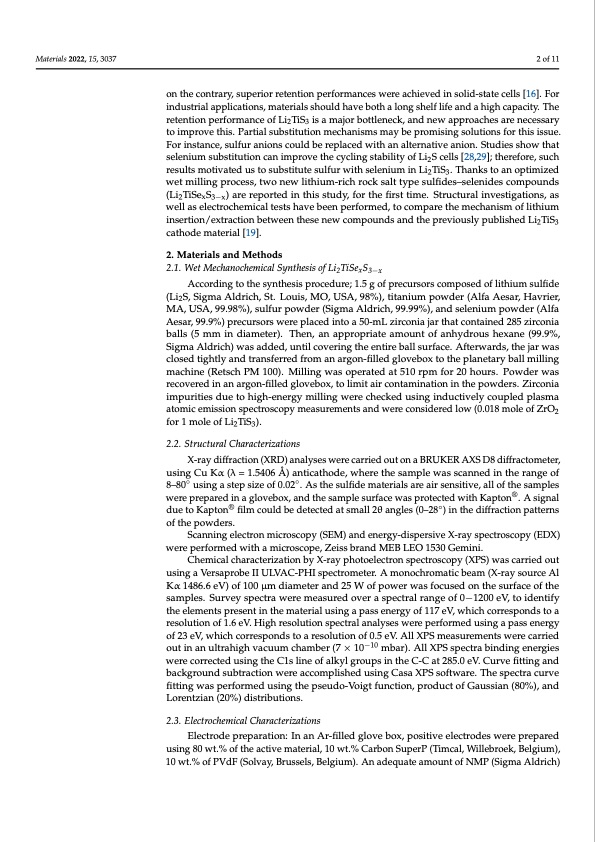
PDF Publication Title:
Text from PDF Page: 002
Materials 2022, 15, 3037 2 of 11 on the contrary, superior retention performances were achieved in solid-state cells [16]. For industrial applications, materials should have both a long shelf life and a high capacity. The retention performance of Li2TiS3 is a major bottleneck, and new approaches are necessary to improve this. Partial substitution mechanisms may be promising solutions for this issue. For instance, sulfur anions could be replaced with an alternative anion. Studies show that selenium substitution can improve the cycling stability of Li2S cells [28,29]; therefore, such results motivated us to substitute sulfur with selenium in Li2TiS3. Thanks to an optimized wet milling process, two new lithium-rich rock salt type sulfides–selenides compounds (Li2TiSexS3−x) are reported in this study, for the first time. Structural investigations, as well as electrochemical tests have been performed, to compare the mechanism of lithium insertion/extraction between these new compounds and the previously published Li2TiS3 cathode material [19]. 2. Materials and Methods 2.1. Wet Mechanochemical Synthesis of Li2TiSexS3−x According to the synthesis procedure; 1.5 g of precursors composed of lithium sulfide (Li2S, Sigma Aldrich, St. Louis, MO, USA, 98%), titanium powder (Alfa Aesar, Havrier, MA, USA, 99.98%), sulfur powder (Sigma Aldrich, 99.99%), and selenium powder (Alfa Aesar, 99.9%) precursors were placed into a 50-mL zirconia jar that contained 285 zirconia balls (5 mm in diameter). Then, an appropriate amount of anhydrous hexane (99.9%, Sigma Aldrich) was added, until covering the entire ball surface. Afterwards, the jar was closed tightly and transferred from an argon-filled glovebox to the planetary ball milling machine (Retsch PM 100). Milling was operated at 510 rpm for 20 hours. Powder was recovered in an argon-filled glovebox, to limit air contamination in the powders. Zirconia impurities due to high-energy milling were checked using inductively coupled plasma atomic emission spectroscopy measurements and were considered low (0.018 mole of ZrO2 for 1 mole of Li2TiS3). 2.2. Structural Characterizations X-ray diffraction (XRD) analyses were carried out on a BRUKER AXS D8 diffractometer, using Cu Kα (λ = 1.5406 Å) anticathode, where the sample was scanned in the range of 8–80◦ using a step size of 0.02◦. As the sulfide materials are air sensitive, all of the samples were prepared in a glovebox, and the sample surface was protected with Kapton®. A signal due to Kapton® film could be detected at small 2θ angles (0–28◦) in the diffraction patterns of the powders. Scanning electron microscopy (SEM) and energy-dispersive X-ray spectroscopy (EDX) were performed with a microscope, Zeiss brand MEB LEO 1530 Gemini. Chemical characterization by X-ray photoelectron spectroscopy (XPS) was carried out using a Versaprobe II ULVAC-PHI spectrometer. A monochromatic beam (X-ray source Al Kα 1486.6 eV) of 100 μm diameter and 25 W of power was focused on the surface of the samples. Survey spectra were measured over a spectral range of 0−1200 eV, to identify the elements present in the material using a pass energy of 117 eV, which corresponds to a resolution of 1.6 eV. High resolution spectral analyses were performed using a pass energy of 23 eV, which corresponds to a resolution of 0.5 eV. All XPS measurements were carried out in an ultrahigh vacuum chamber (7 × 10−10 mbar). All XPS spectra binding energies were corrected using the C1s line of alkyl groups in the C-C at 285.0 eV. Curve fitting and background subtraction were accomplished using Casa XPS software. The spectra curve fitting was performed using the pseudo-Voigt function, product of Gaussian (80%), and Lorentzian (20%) distributions. 2.3. Electrochemical Characterizations Electrode preparation: In an Ar-filled glove box, positive electrodes were prepared using 80 wt.% of the active material, 10 wt.% Carbon SuperP (Timcal, Willebroek, Belgium), 10 wt.% of PVdF (Solvay, Brussels, Belgium). An adequate amount of NMP (Sigma Aldrich)PDF Image | Lithium-Rich Rock Salt Type Sulfides-Selenides

PDF Search Title:
Lithium-Rich Rock Salt Type Sulfides-SelenidesOriginal File Name Searched:
materials-15-03037-v2.pdfDIY PDF Search: Google It | Yahoo | Bing
Product and Development Focus for Salgenx
Redox Flow Battery Technology: With the advent of the new USA tax credits for producing and selling batteries ($35/kW) we are focussing on a simple flow battery using shipping containers as the modular electrolyte storage units with tax credits up to $140,000 per system. Our main focus is on the salt battery. This battery can be used for both thermal and electrical storage applications. We call it the Cogeneration Battery or Cogen Battery. One project is converting salt (brine) based water conditioners to simultaneously produce power. In addition, there are many opportunities to extract Lithium from brine (salt lakes, groundwater, and producer water).Salt water or brine are huge sources for lithium. Most of the worlds lithium is acquired from a brine source. It's even in seawater in a low concentration. Brine is also a byproduct of huge powerplants, which can now use that as an electrolyte and a huge flow battery (which allows storage at the source).We welcome any business and equipment inquiries, as well as licensing our flow battery manufacturing.| CONTACT TEL: 608-238-6001 Email: greg@salgenx.com | RSS | AMP |